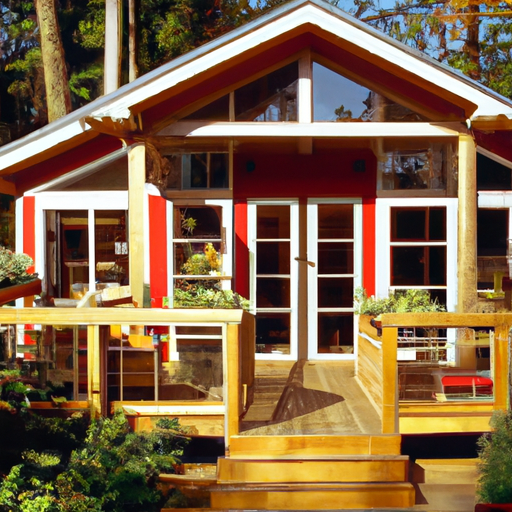
In the world of sustainable home design, staying up to date with the latest trends is essential. As we strive to create homes that are eco-friendly and energy-efficient, it’s important to know what design choices are currently shaping the industry. From incorporating natural materials to maximizing natural light and implementing smart home technology, the emerging trends in sustainable home design are all about creating a harmonious balance between comfort, sustainability, and style. In this article, we’ll explore these trends and provide you with inspiration for your own environmentally-conscious home design journey.

1. Incorporation of Renewable Energy Sources
Incorporating renewable energy sources is a key trend in sustainable home design that not only reduces reliance on fossil fuels but also promotes a cleaner environment. One prominent renewable energy source commonly used in sustainable homes is solar panels. These panels harness the power of the sun to generate electricity, which can be used to power various appliances and systems within the house.
Another popular renewable energy source employed in sustainable home design is wind turbines. These turbines harness the power of the wind to generate electricity, which can be a valuable addition to the home’s energy grid. By harnessing the power of natural wind, homeowners can reduce their dependence on traditional energy sources, significantly lowering their carbon footprint.
Geothermal heating is another effective method of incorporating renewable energy sources into sustainable home design. This technology utilizes the stable temperature below the earth’s surface to regulate the heating and cooling needs of a house. Geothermal heat pumps extract heat from the earth during winter and transfer it indoors, while in the summer, they remove heat from the house and release it back into the ground.
2. Efficient Water Management Systems
Efficient water management systems are crucial in sustainable home design as they help conserve water and reduce the strain on natural resources. One effective method of achieving this is through the implementation of greywater recycling systems. Greywater refers to lightly used water from sources such as sinks, showers, and laundry machines, which can be treated and reused for irrigation or toilet flushing. By recycling greywater, homeowners can significantly reduce their overall water consumption and contribute to a more sustainable water management system.
Rainwater harvesting is another important technique used in sustainable home design for water conservation. By collecting rainwater using specially designed systems and storing it for later use, homeowners can minimize their reliance on municipal water supplies. This harvested water can then be used for various purposes such as irrigation, toilet flushing, and general household cleaning, reducing the strain on freshwater sources.
Smart irrigation systems are also gaining popularity in sustainable home design. These systems utilize weather data and remote sensing technology to optimize irrigation practices and minimize water waste. By monitoring soil moisture levels and weather patterns, smart irrigation systems ensure that plants receive the right amount of water at the right time, preventing overwatering and reducing overall water consumption.
3. Passive Design Principles
Passive design principles focus on utilizing natural elements and strategies to maximize comfort and minimize energy consumption in a home. One such principle is natural ventilation, which involves strategically placed windows, vents, and building orientation to allow for the free flow of fresh air throughout the house. By harnessing natural air movement, homeowners can reduce their reliance on mechanical cooling systems, leading to energy savings and a more sustainable home.
Daylighting is another essential element of passive design principles. By incorporating ample windows and skylights, natural light can be utilized to illuminate the interior spaces of a home during the day, reducing the need for artificial lighting. This not only conserves energy but also promotes a healthier and more comfortable living environment.
Thermal mass refers to the ability of a material to absorb and store heat. By incorporating materials with high thermal mass, such as concrete or earthen walls, sustainable homes can regulate indoor temperatures more effectively. During the day, thermal mass materials absorb excess heat from sunlight, preventing the interior from overheating. At night, these materials release the stored heat, helping to maintain a comfortable temperature without the need for mechanical heating systems.
4. Use of Recycled and Environmentally Friendly Materials
Using recycled and environmentally friendly materials is a crucial aspect of sustainable home design that promotes resource conservation and reduces the negative environmental impact of construction. Sustainable wood, sourced from responsibly managed forests, is a popular choice for building materials. By choosing sustainably harvested timber, homeowners can support the preservation of forests and ensure responsible forestry practices.
Recycled steel is another commonly used material in sustainable home design. Steel is highly durable and can be easily recycled into new products, reducing the need for resource-intensive mining and manufacturing processes. By incorporating recycled steel into the construction of a home, homeowners can help reduce the demand for virgin steel and minimize the environmental impact of the building industry.
Bamboo flooring is a sustainable alternative to traditional hardwood flooring. Bamboo is a fast-growing grass that can be harvested within a few years, making it an environmentally friendly choice. Additionally, bamboo flooring is highly durable and can add a natural and aesthetically pleasing touch to sustainable home designs.

5. Integration of Smart Home Technologies
Smart home technologies are playing an increasingly important role in sustainable home design by optimizing energy usage and enhancing overall efficiency. Energy management systems are one example of smart home technology that allows homeowners to monitor and control their energy consumption. These systems typically include smart meters, energy monitors, and mobile apps that provide real-time data and enable users to make informed decisions about their energy usage.
Connected appliances are another integral part of sustainable home design. Smart refrigerators, washing machines, and other appliances can be programmed to operate during off-peak hours or when renewable energy sources are abundant. This helps maximize the use of clean energy and reduce reliance on traditional energy sources.
Automated lighting systems are also gaining popularity in sustainable home design. These systems utilize sensors and timers to control lighting based on occupancy and natural light availability. By automatically adjusting lighting levels and turning off lights when they are not needed, homeowners can reduce energy waste and lower their electricity bills.
6. Green Roofs and Living Walls
Green roofs and living walls are two innovative techniques in sustainable home design that bring nature into the built environment while providing numerous environmental benefits. Vegetation on rooftops helps reduce urban heat island effect by absorbing and dissipating heat, improving air quality, and providing insulation. Additionally, green roofs can contribute to rainwater management by absorbing and retaining rainfall, reducing the strain on stormwater systems.
Vertical gardens or living walls are another excellent way to incorporate nature into sustainable home design. These walls are covered with plants that grow vertically, creating a visually appealing and environmentally beneficial feature. Living walls help improve indoor air quality by absorbing pollutants and emitting oxygen. They also offer insulation properties and can regulate temperature and humidity levels within the home.
Green facades, similar to living walls, involve the vertical greening of building facades. These facades not only provide aesthetic appeal but also help reduce the energy demands of a building by shading it from the sun’s heat. By integrating green facades into sustainable home design, homeowners can create a more pleasant and eco-friendly living environment.

7. Emphasis on Indoor Air Quality
Indoor air quality is a critical consideration in sustainable home design as it directly impacts the health and well-being of occupants. Air purification systems are becoming increasingly popular in sustainable homes, helping to remove pollutants and improve air quality. These systems utilize filters and other technologies to remove particles, allergens, and harmful VOCs (volatile organic compounds) from the indoor air, promoting a healthier living environment.
Using low-VOC (volatile organic compound) paints is another crucial aspect of sustainable home design. Traditional paints contain chemical compounds that release harmful gases known as VOCs into the air, contributing to poor indoor air quality. By choosing low-VOC or VOC-free paints, homeowners can minimize exposure to these harmful compounds and create a healthier indoor environment.
Natural fiber carpets are a sustainable alternative to conventional synthetic carpets. Natural fibers, such as wool or sisal, are not only biodegradable and renewable but also have a lower environmental impact compared to synthetic materials. Natural fiber carpets can help improve indoor air quality by reducing the concentration of airborne particles and allergens, making them an excellent choice for sustainable home design.
8. Implementation of Sustainable Landscaping
Sustainable landscaping is an integral part of sustainable home design that focuses on reducing water usage, minimizing maintenance requirements, and promoting biodiversity. Incorporating native plants into the landscape design is an effective strategy to create a sustainable and resilient outdoor space. Native plants are well-adapted to local climate conditions, require less water and maintenance, and provide habitat for local wildlife.
Permeable paving is another aspect of sustainable landscaping that helps reduce stormwater runoff. Unlike traditional impermeable surfaces, permeable paving materials allow rainwater to infiltrate into the ground, replenishing groundwater and reducing the strain on stormwater systems. This reduces the risk of flooding and erosion and promotes sustainable water management practices.
Drip irrigation is an efficient method of watering plants in sustainable landscaping. Unlike traditional sprinkler systems, which can result in significant water loss due to evaporation and runoff, drip irrigation delivers water directly to the plant roots, minimizing water waste. By utilizing drip irrigation systems, homeowners can conserve water and ensure that plants receive the right amount of water for optimal growth.

9. Integration of Smart Home Technologies
As mentioned earlier, integrating smart home technologies is a key trend in sustainable home design. Energy management systems, connected appliances, and automated lighting systems all play a role in optimizing energy usage and enhancing energy efficiency. By utilizing these technologies, homeowners can reduce their energy consumption, lower their utility bills, and contribute to a more sustainable lifestyle.
10. Emphasis on Passive Cooling Strategies
Passive cooling strategies are essential in sustainable home design, particularly in regions with hot climates. Shading devices, such as awnings or overhangs, are employed to block direct sunlight from entering the interior spaces of a home. By minimizing solar heat gain, shading devices reduce the need for mechanical cooling systems and help maintain a comfortable indoor temperature.
Insulated walls are another crucial component of passive cooling strategies. Insulation helps prevent heat transfer between the interior and exterior of a home, keeping the indoor space cooler during hot weather. By employing high-quality insulation materials and proper construction techniques, homeowners can significantly reduce their reliance on air conditioning systems and lower their energy consumption.
Cool roofs, typically light-colored or reflective surfaces, are designed to reflect more sunlight and absorb less heat compared to traditional dark-colored roofs. By installing cool roofs, homeowners can minimize the solar heat gain on their roofs, reducing the need for air conditioning and mitigating the urban heat island effect.
In conclusion, sustainable home design encompasses a wide range of strategies and technologies that aim to create energy-efficient, environmentally friendly, and comfortable living spaces. Incorporating renewable energy sources, efficient water management systems, passive design principles, recycled and environmentally friendly materials, smart home technologies, green roofs and living walls, emphasis on indoor air quality, sustainable landscaping, and passive cooling strategies are all key emerging trends in sustainable home design. By implementing these strategies, homeowners can not only reduce their environmental impact but also enjoy the benefits of lower energy bills, improved indoor air quality, and a healthier living environment.

